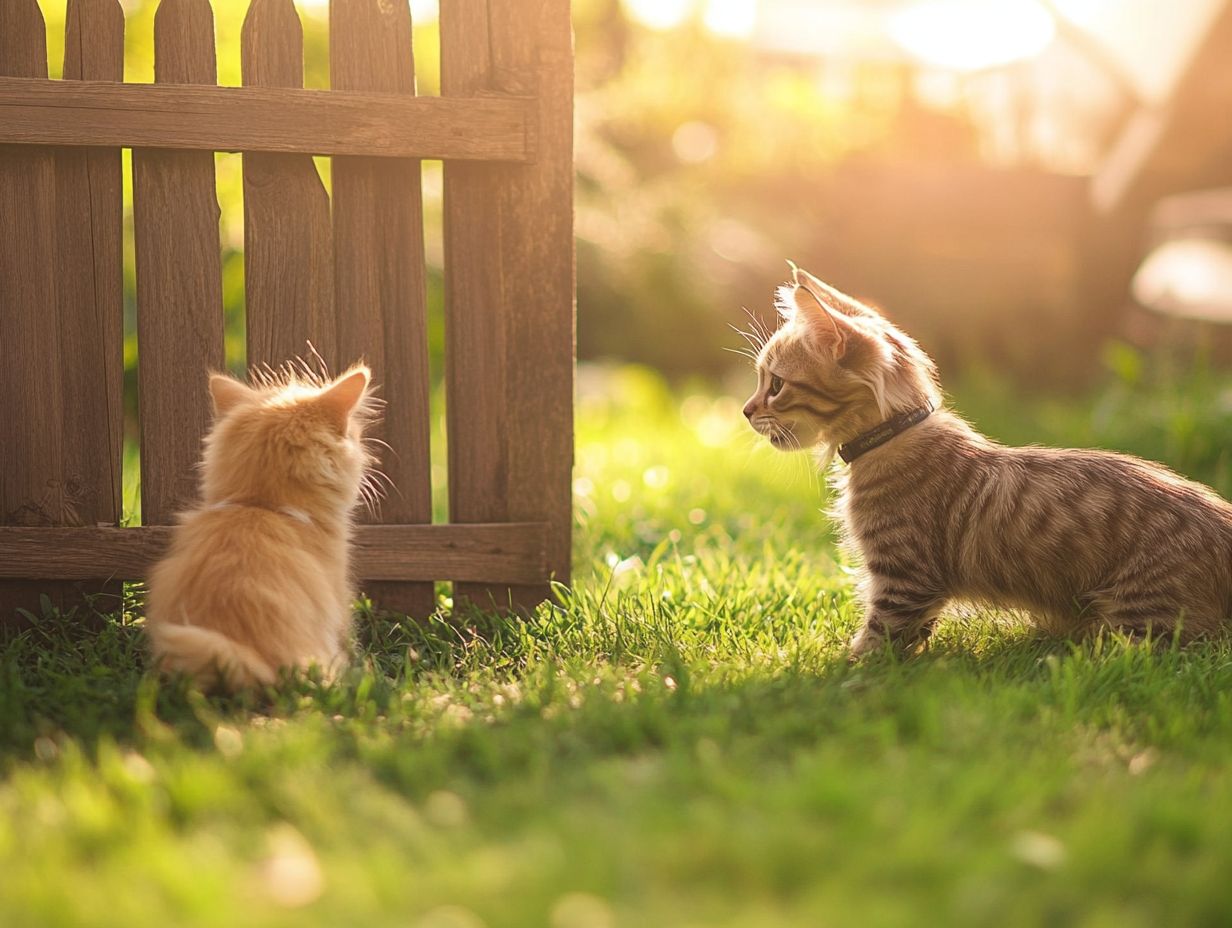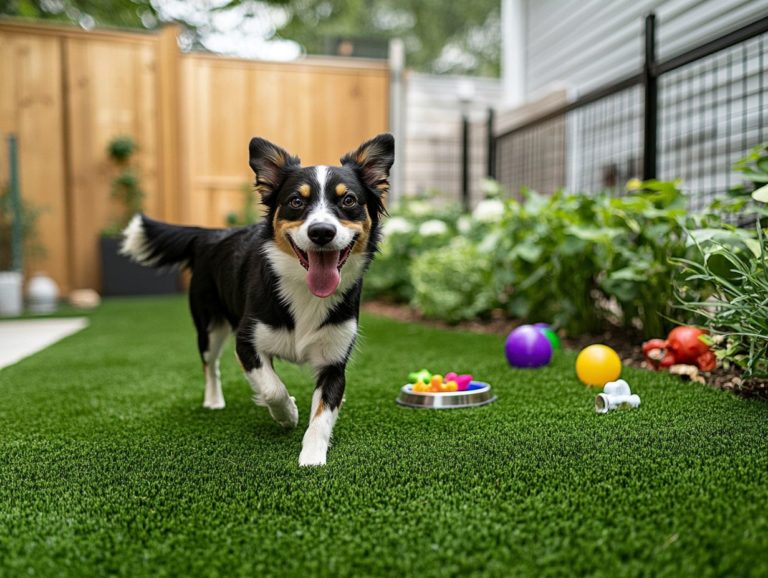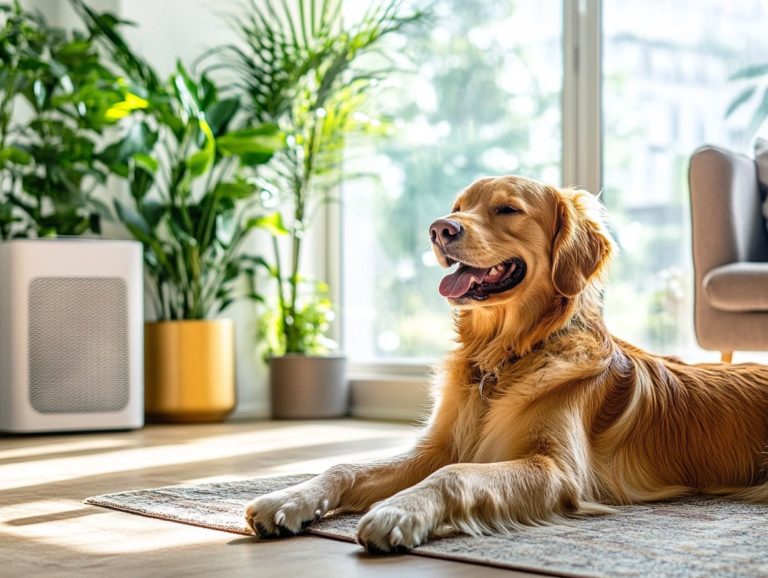Using Gates to Create Safe Spaces for Pets
Pet gates are essential for pet owners who want to create safe and secure environments for their beloved companions. Whether you want to keep an inquisitive puppy out of the kitchen or prevent a feline from climbing the stairs, selecting the right pet gate can transform your living space.
In this article, you’ll explore the diverse range of pet gates available, receive guidance on choosing the ideal one tailored to your needs, and uncover effective setup and maintenance strategies. Discover how pet gates can elevate your home life while ensuring your pets’ safety.
Contents
- Key Takeaways:
- Types of Pet Gates
- Choosing the Right Pet Gate
- Setting Up a Pet Gate
- Benefits of Using Pet Gates
- Tips for Using Pet Gates Effectively
- Frequently Asked Questions
- 1. How can I use gates to create a safe space for my pet?
- 2. What are some benefits of using gates for my pet?
- 3. How do I choose the right gate for my pet?
- 4. Can I use a gate to train my pet?
- 5. Are there any safety precautions I should take when using gates for my pet?
- 6. Can I use a gate for other pets besides dogs?
Key Takeaways:

- Pet gates are useful for creating safe spaces for pets in the home and can also have other uses.
- There are different types of pet gates, including freestanding, pressure-mounted, and hardware-mounted, each offering unique benefits.
- Proper placement, installation, and maintenance are important for effective use of pet gates. Training pets to use them can help promote safety and boundaries.
What are Pet Gates and Why are They Useful?
Pet gates are important tools in homes with children and pets. They create a barrier that enhances safety and offers peace of mind. By delineating safe spaces, pet gates facilitate manageable interactions among family members, enabling effective supervision and creating cozy corners for pets.
This enriches the emotional well-being and physical health of pets and children, fostering a harmonious atmosphere at home. These gates promote positive habits as well, proving invaluable during house training for puppies and kittens. They establish necessary boundaries, keeping pets away from restricted areas like kitchens or stairs.
For families with energetic young children, pet gates provide an immediate solution for supervising spirited activities, ensuring pets remain comfortable in their designated spaces, perhaps surrounded by their favorite chew toys or a snug dog crate.
Take, for instance, the Richell Cat Safety Gate, which exemplifies a design that marries functionality with style. It not only fulfills its primary purpose effectively but also enhances your home decor, making it a chic addition to your living space.
Types of Pet Gates
Pet gates come in various types, each designed carefully to meet unique needs and fit diverse environments. This ensures a tailored approach to managing your pets while prioritizing their safety.
Whether you’re dealing with energetic puppies or seasoned dogs, selecting the appropriate dog gate is essential for establishing effective boundaries and safe havens within your home.
Freestanding, Pressure-Mounted, and Hardware-Mounted Gates
The three primary types of pet gates freestanding, pressure-mounted, and hardware-mounted each offer unique advantages for creating safe spaces for your pets. Understanding their characteristics is crucial for making an informed decision that aligns with your home organization and safety needs.
Each type serves different purposes and fits various locations within your home, ensuring your furry friends have a secure environment to thrive. Freestanding gates are perfect for flexibility; you can easily move them around and position them wherever you need them.
Pressure-mounted gates are great for doorways or between rooms, providing a secure fit without damaging your walls making them an excellent choice for renters. On the other hand, hardware-mounted gates are a long-term solution, anchored directly to the wall, ideal for high-traffic areas where extra stability is essential.
When selecting the right gate, consider factors like the height of the gate, the strength of the material, and chew-proof options to ensure both safety and comfort for your pets.
Choosing the Right Pet Gate
Choosing the right pet gate is an important task that requires thoughtful consideration of several factors, ensuring the safety and comfort of both your pets and children. Assess your specific requirements to create secure spaces that enhance emotional well-being and promote effective management within your home.
Don t wait! Choose the right pet gate today for a safer home!
Factors to Consider

When selecting a pet gate, consider critical factors like safety, durability, and the unique needs of your pets and children. Each of these is an important part of creating a secure environment.
The gate’s height is a key consideration. It should be tall enough to prevent even the most adventurous pets from climbing over. Material choice matters too options like wood and metal offer different levels of resistance to damage.
A straightforward setup makes using the gate a breeze! Supervision during those first uses helps pets and children adjust, fostering a comfortable and secure environment for your family.
Setting Up a Pet Gate
Setting up a pet gate correctly is essential for maximizing its effectiveness in safeguarding pets and children. Proper placement and installation enhance the gate’s functionality and create clear boundaries.
Proper Placement and Installation
To achieve maximum effectiveness, it’s crucial to properly place and install a pet gate. This creates a safe haven for both your pets and children, reducing risks and accidents while improving supervision.
Position pet gates in high-traffic areas like the kitchen or play zones to better manage your pets’ movement. This keeps them away from hazardous spots especially when cooking or when toys are scattered.
Ensure the gate is securely anchored and free from sharp edges to protect your furry companions and little ones. Opt for adjustable gates with easy access mechanisms for better functionality and monitoring.
Benefits of Using Pet Gates
Incorporating pet gates into your home provides numerous advantages, especially in creating secure environments for pets and children. These barriers help manage interactions and enhance the emotional well-being of everyone in your household.
Creating Safe Spaces for Pets
Creating safe spaces for pets is a key benefit of using pet gates. They allow pets to enjoy cozy retreats without worrying about accidents, which enhances their emotional well-being.
By placing pet gates throughout your home, you can create zones that promote relaxation. Imagine a tranquil corner in the living room or a cozy nook in the bedroom both serve as perfect getaways from daily chaos.
These safe spaces not only reduce anxiety; they also provide pets with a sanctuary to unwind when life gets overwhelming. Keeping your pets contained streamlines routines during mealtimes or when welcoming new visitors, improving their quality of life.
Other Uses for Pet Gates

Beyond safeguarding pets and children, pet gates serve multiple functions, such as establishing boundaries and enabling separation when necessary. Their versatility makes them invaluable tools for families managing their living spaces.
During training sessions, these gates designate specific areas for activities like eating or playing. They also help introduce new pets gradually, minimizing stress for all animals involved.
Pet gates can restrict access to potentially dangerous areas like kitchens or basements. Whether keeping a curious puppy away from the laundry room or creating a peaceful nook for a shy cat, their adaptability fosters harmony in any household.
Tips for Using Pet Gates Effectively
To maximize pet gates, use specific strategies that enhance their use and lifespan. These thoughtful approaches bolster safety within the home and help integrate pets into everyday life.
Training Pets to Use Gates
Training your pet to understand and respect pet gates is vital for keeping pets safe in your home. With proper guidance and reinforcement, your pet can learn to navigate their surroundings while honoring the safe spaces you’ve established.
This training creates a sense of security for both you and your pet and helps prevent accidents from unrestricted access. A key method is rewarding good behavior like approaching the gate calmly or stopping when instructed so your pet associates the gate with positive outcomes.
Consistency is essential. Use clear commands and supervise your pet during this learning phase to reinforce their understanding of boundaries. As you gradually expose them to the gate, their comfort will increase, making the learning experience both effective and enjoyable.
Maintaining and Cleaning Gates
Keep your pet gates in tip-top shape! Regular maintenance ensures they last longer and keep your pets safe. By utilizing durable materials, you can make this process smoother.
Incorporate a consistent cleaning schedule to prevent the buildup of dirt and debris that can affect the gate s operation. For wooden gates, use a gentle combination of soap and water. Metal gates may benefit from a rust-resistant spray to maintain optimal condition. Avoid harsh chemicals that could damage the finish or compromise the materials.
By following these guidelines, you can ensure your gates perform effectively and remain a safe haven for your beloved companions.
Frequently Asked Questions
1. How can I use gates to create a safe space for my pet?

Gates can block off certain areas of your home, such as stairs or a designated room, creating a safe space for your pet. This helps prevent accidents and keeps them contained in a secure area.
2. What are some benefits of using gates for my pet?
Using gates provides a sense of security and comfort for your pet by giving them their own designated space to retreat to. It also helps prevent access to potentially dangerous areas of your home.
3. How do I choose the right gate for my pet?
When choosing a gate, consider the size, material, and purpose. Ensure it is sturdy and tall enough to keep your pet safely contained. A gate with a built-in pet door may add convenience.
4. Can I use a gate to train my pet?
Yes, gates are useful tools for pet training. They can limit access to certain areas and encourage good behavior. For example, block off a room while training your pet to stay off the furniture.
5. Are there any safety precautions I should take when using gates for my pet?
Ensure the gate is properly installed and secured to prevent your pet from knocking it over or escaping. Regularly check for wear and tear on the gate and replace it if needed.
6. Can I use a gate for other pets besides dogs?
Yes, gates can be used for various pets, such as cats, rabbits, or even small exotic animals. Just choose a gate appropriate for the size and behavior of your specific pet.






